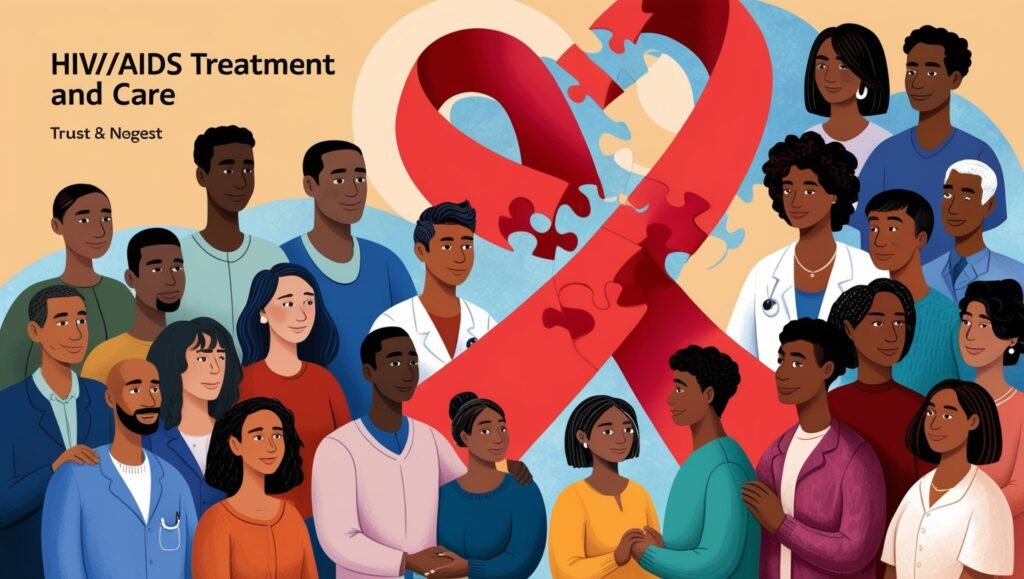Hello everyone!
AIDS also known as Acquired Immunodeficiency Syndrome has been one of the unprecedented challenges that the global health sector has had to face in the last few years. It is an illness that stems from the Human Immunodeficiency Virus (HIV) that weakens the body’s defense system, the immune system, enabling the body to fight infections and diseases.
As with most diseases, it is important to understand HIV and AIDS not only for those who are already infected but also for those who want to know about the state of health around the world. Fortunately, there has been a revolution on the treatment of people living with HIV/AIDS thanks to the improvement of health care. This blog post seeks to explain what AIDS is, its impact on the bodies and the new directions in the health facility that are real.
What is HIV/AIDS
HIV (Human Immunodeficiency Virus) is a virus that affects the immune system by destroying the HIV’s target cells, T cells which are essential in managing infections. Such diseases surface when the immunity of the human body becomes severely compromised by various diseases, and some types of cancer. This last stage of HIV is referred to as Acquired Immune Deficiency Syndrome or AIDS.
HIV is spread with the exchange of certain body secretions of an HIV infected individual, these include: blood, semen, vaginal secretions, rectal fluids and breast milk. Which include unprotected sexual contact, use of needles including syringe or other striking instruments contaminated with the virus and from mother to child during childbirth and breastfeeding.
AIDS on the other hand is the terminal stage of the HIV infection and therefore not all people with HIV will be affected by AIDS. AIDS, as we know, is caused by the HIV virus; if a person gets the right medical attention he or she needs, HIV can be managed. Most of the AIDS patients have a very low number of CD4 cells with an average number ranging and they are also affected by numerous opportunistic diseases or infections.
How HIV Affects Our Body
HIV targets and destroys T helper cells – cells that are critical to the human immune system. When the level of CD4 cells is low, the body’s immune system weakens and is thus not capable of fighting off infections and diseases. If left untreated, HIV can cause a great deal of harm to one’s immune system which opens the individual to conditions such as pneumonia or tuberculosis or cancer such as Kaposi’s sarcoma or lymphoma.
The time it takes – for one individual to progress from HIV to AIDS – differs from every other. Some of the individuals will develop AIDS a few years after being infected while others may take a longer time. The stages depend on such factors as the subject’s general health condition, the reaction of the immune system to the virus, and the treatment where applicable.
Improvement in Health Care of HIV/AIDS

Antiretroviral Therapy (ART)
Another important discovery that has been made over the years is the use of Antiretroviral Therapy commonly known as ART. ART means the prescription of a set of HIV medicines that have to be consumed daily.
These medicines are not for the cure of HIV but are used by people with HIV to improve their life spans, increase their quality of life and decrease the chances of passing HIV to others. ART achieves its goal through lowering the amount of the virus in the blood to below the level that can be detected by common tests.
When the viral load is undetectable, we can no longer assume that the virus is passing on to the sexual partners and the human immune system is slightly able to bounce back to normalcy.
Pre-Exposure Prophylaxis (PREP)
PrEP is a primary medical treatment for HIV prevention of those at risk. This is a form of therapy that comes with the use of a tablet that has two antiretroviral substances to be used every day. When PrEP is taken as prescribed, it can greatly decrease one’s likelihood of getting HIV through sex or sharing needles. It is very beneficial especially for this group and when administered properly it has proved to be very effective.
Post-Exposure Prophylaxis (PEP)
PEP is a post-exposure prophylaxis which is an anti-HIV medicine that is taken for 72 hours after an individual may have been exposed to HIV. This is only in cases where there are high chances that someone has contracted HIV day through being scratched with a needle or having an affair with an HIV positive person. PEP should be initiated as early as possible and has to be completed within a 28 day course.
HIV Vaccine Research
However, there is no vaccine for HIV as it is at the moment though scientists and researchers are trying as hard as they can to come up with one. Several candidates of the vaccine are still going through trials, with the general objective of strengthening the immune response against the virus. It remains a challenge to develop vaccines because of the high mutation rate of HIV and its ability to alter its form in order to avoid being attacked by the body’s immune system but there has been considerable progress.
Long-Acting Injectables
There are current forms of HIV treatment where people take consistent oral drugs daily but new long acting injectable formulations are being developed. These injectables are given monthly or even less frequently and this means that the patients will embrace treatment regimens much easier compared to others. These slow release medications provide an additional choice in approaching AIDS and enhancing one’s overall experience of living.
Advances in Diagnostic Tools
It is therefore important for people to get HIV tested and know their status early enough so that they can receive adequate treatment. With the development of new diagnostic techniques the HIV and the health of the infected individuals can be easily diagnosed and tracked. These include the rapid diagnostic tests that require less time to generate results as well as the self-testing kits. It enables the treatment to be given at an early stage to avoid developing into AIDS and hence minimize the spread of the virus.
SPONSORSHIP FOR CARE AND PSYCHOLOGICAL SERVICES
Approaching illness seriously include several factors other than medication especially when the ailment is a chronic one such as HIV/AIDS. Psychological, and even psychiatric, intervention are important as well as counseling and needful social services. This means HIV positive people face emotional and social problems, therefore being a recipient of mental health services, support groups and counseling among others remains key to their management.
Global Initiatives and Awareness
International organizations including United Nations Global Fund and the President’s Emergency Plan for AIDS Relief (PEPFAR) have played significant roles in increasing HIV testing, treatment, and prevention service provision across the globe. These include creating public-awareness campaigns and educational programmes for the prevention of stigma, for promoting safe behaviors, advocating for testing and treatment.

The HIV/AIDS Care as Expected Future
There is the hope that the future HIV/AIDS care is sure to be brighter given the research and development taking place that seek to enhance the lives of the people affected with the virus. Research and development departments in the science and medical field are looking for more efficient ways of therapies and cure and better vaccines. Efforts that will be required in the eradication of HIV/AIDS include elimination of stigma, and improving access to health care. Affordability of the modern treatments and prevention means is also a very important aspect that should be addressed to progress more in the near future.
Conclusion
Thus, despite the existence of HIV/AIDS as a major problem in the contemporary world, there have been improvements in medical treatment, which have shifted the perspective for people that are HIV positive. With efficient treatments, good preventions, and additional research, we are getting closer to living in a world with HIV/AIDS. Prevention of HIV/AIDS requires targets in the areas of education, awareness, and access to care; and furthering such a mission will be significant in creating such a future.
Frequently Asked Questions on Health Care Accessibility
- What is Google Addition Called Satellite Connectivity on Android 14?
Satellite connectivity for Android 14: Google is adding satellite connectivity for a smartphone to get internet access and communicate with your contacts if the cellular networks are unavailable. According to this feature it wants to offer reliable communication where there may be little or no network providers.
- How can satellite phones be connected?
Satellite connection involves use of satellites that are located above the surface of the earth to communicate signals to and from devices on the surface. Satellites operate differently from cellular networks that utilize towers on the ground to transmit signals; this service offers Internet connection to devices and communication services in regions where cellular networks are unavailable.
- Self-employment offers flexibility for many people of employment, but what are the advantages of the new feature that has now been implemented?
The benefits of the satellite connectivity feature include The benefits of the satellite connectivity feature include:
- Global Coverage: In regards to its products, it provides Internet connectivity in the rural and unserved markets.
- Enhanced Safety: Provides a means to communicate during disasters especially in the areas that are harder to reach or during disasters which have affected communication infrastructure.
- Improved Connectivity: It guarantees more stable connection in areas with no signal or weak signal from the cellular network providers.
- Economic Opportunities: offering the prospects of new opportunities for businesses as well as the individual out in the rural areas.
- This is actually a question any product developer wants to ask: ‘Will this feature work everywhere?”
Nevertheless, depending on the geographic locale, the feature should yield numerous results, though it is not necessarily going to be accessible in all regions at once. Accessibility and availability are defined by satellite communications networks which can have issues pertaining to delays and signal strength.
- What features affect the functioning of emergency services?
The connectivity feature of the satellite improves how one can get to the emergency services when in areas, which may be devoid of other networks’ signals. Sometimes availability of an independent communication path is desirable, especially in cases of disaster or other emergencies.





